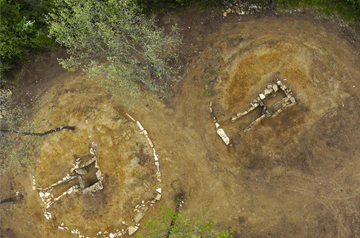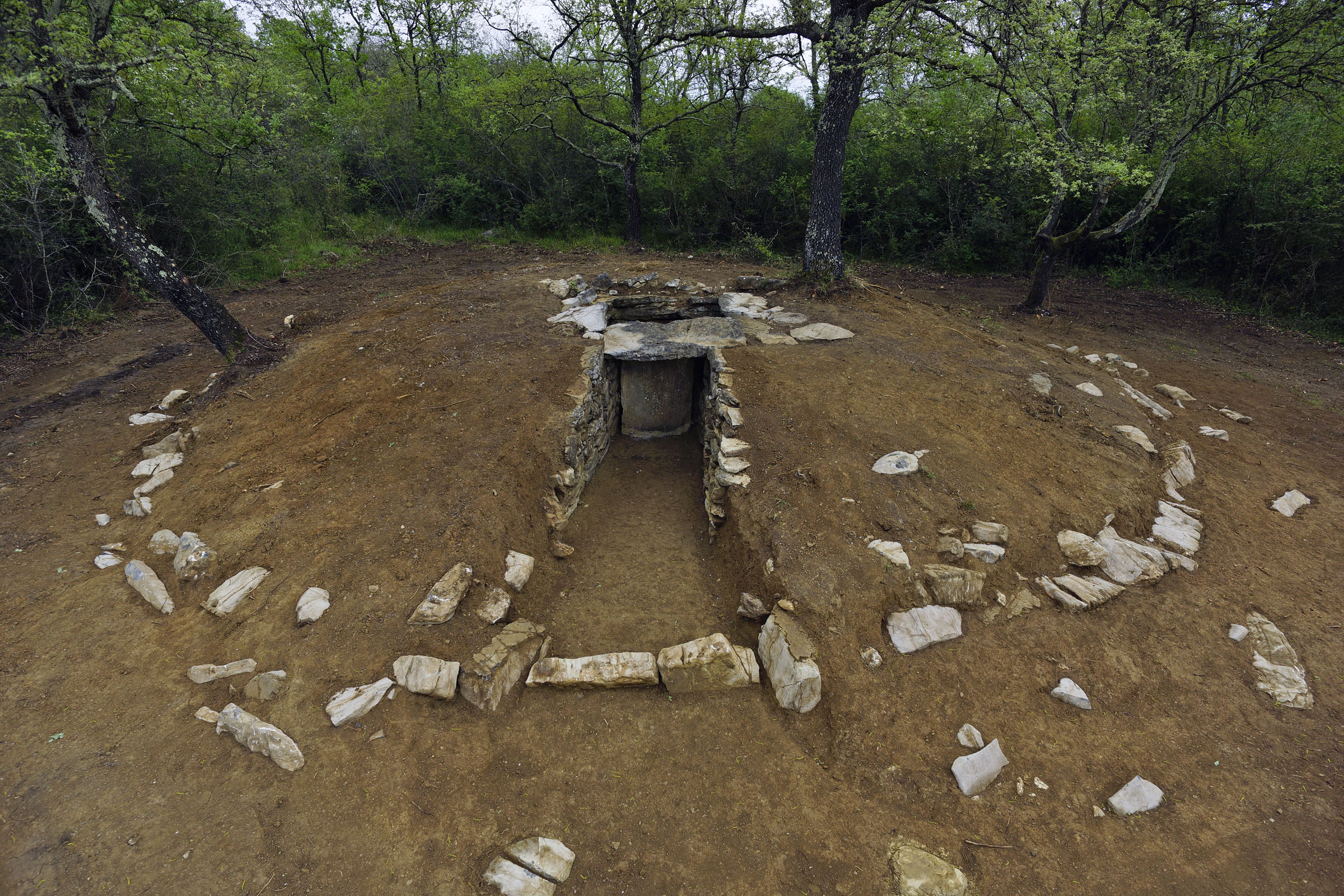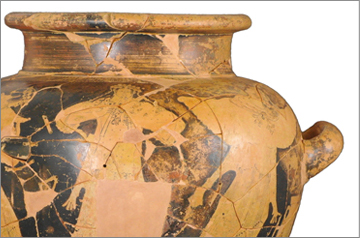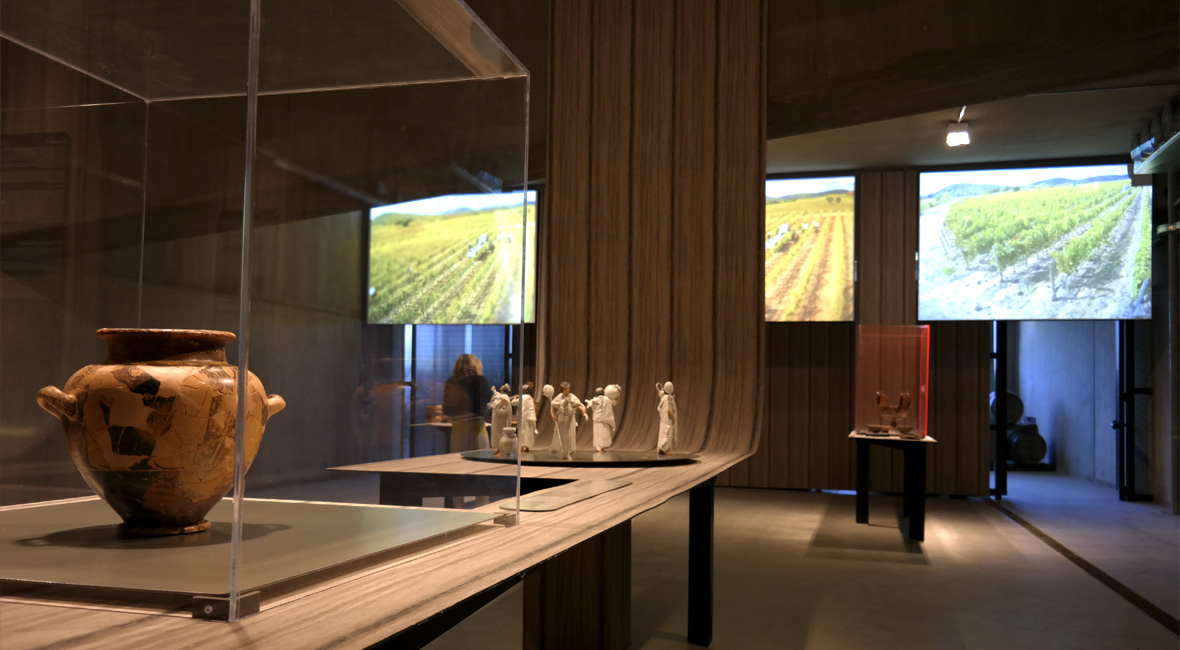Rocca di Frassinello and the Etruscans
An archaeological journey that unwinds through the vineyards of the Rocca di Frassinello, and a room inside the cellar designed by architect Italo Rota, creator of the Wine Pavilion for the Milan Expo, allowing visitors to immerse themselves in the sounds and ancient visions of the world of the Etruscans. Reconnecting that thread which, through wine, ties together the modern viticulture to the Etruscan civilisation that once flourished precisely in this land more than 2,000 years ago.
This is the philosophy behind the project that at its core focuses on the discovery of the Etruscan necropolis of San Germano, one of the most important archaeological sites of the area encompassing the ancient city of Vetulonia. The initiative was founded thanks to the collaboration between the Archaeological Superintendence of Tuscany, the Etruscan Civilisation and Italic Antiquities programme at the University of Florence and Paolo Panerai, who for some time now has helped transform the Rocca di Frassinello into an aggregate hub of art and culture under the banner of wine, with the patronage of the municipality of Gavorrano.
The Etruscan necropolis of San Germano, extending on both sides of the Sovata Valley, an important connecting route in the territory of the ancient Etruscan city of Vetulonia, is composed of burial mounds (tumuli). The archaeological area of the Rocca di Frassinello sees the concentration of the better known tumuli of the necropolis, built between the second half of the 7th century BC and the first half of the 6th century BC: eight monumental tombs have been recovered, restored and opened to the public.
The exhibition of artefacts near the barrel room managed by Biancamaria Aranguren and Luca Cappuccini displays various objects recovered from the tombs of the Rocca di Frassinello archaeological area. The tombs, which had already been raided in the past, have nonetheless offered a number of objects that accompanied the deceased in the afterlife. The artefacts for the most part consist of finely painted ceramic vases (of Etruscan-Corinthian origin) and “bucchero” vases, “unguentaria” of various shapes, used to store scented body oils and chalices and cups for wine consumption. A number of rare personal ornaments have also been found, such as brooches and earrings, mostly made of bronze but also in precious metals.
Adjacent to the Rocca di Frassinello archaeological site, on the grounds of the Poggio all’Olivo estate, the Archaeological Superintendence of Tuscany in collaboration with the Etruscan Civilisation and Italic Antiquities programme at the University of Florence have examined another large tumulus of the San Germano necropolis, which presents a more complex structure than the others, with parallels to the large “princely” burial mounds of Vetulonia. Already looted in ancient times, the tomb has nonetheless offered many important artefacts that bear witness to the continued use of this tomb from the late 7th to the 3rd century BC and give testimony to the Etruscan passion for wine. The high rank of the owners of the tomb is underscored by the presence of two iron axes, a number of elements belonging to a “currus” (war chariot similar to a “biga” chariot), rare alabaster vases of Egyptian craftsmanship, as well as pottery imported from the Eastern Mediterranean region and Greece.
The large “stamnos” vase recovered in fragments in the northern section of the tumulus and which was subject to a meticulous restoration process, was crafted and painted in Athens around 480 BC. Its use as a container for wine is reaffirmed by the Dionysian procession that decorates it, a veritable ode to this precious drink.
Italo Rota’s idea to extract the characters depicted on the vase, allowing them to emerge from the two-dimensionality of their original medium, recreating the garments and ornaments of the Dionysian procession, has made it possible, thanks to the use of 3D technology, to bring out the volumes and the movement of the procession, releasing them from the constraints of the circular path depicted by the stamnos. Inspired by the decorations on the vase, a short narrative on wine unfolds, a precious resource that has served as a status symbol since Etruscan times: members of a local aristocracy, the Etruscans of the Rocca di Frassinello archaeological area imitate the princely class, dedicating themselves to the pleasure of eating and drinking.
Wine consumption was for the most part an activity carried out on social occasions, according to very specific rituals. Before the arrival of the Greek fashion, which involved the use of a large vessel to dilute wine with water and poured into large goblets (known as “kylikes”), in Vetulonia, vases typical of local tradition were used. This is illustrated, for example, by the vases found in the tumulus V trench tomb (fossa) of the necropolis of Santa Teresa, town located a few kilometres from San Germano. Dating back to 630 BC, the monumental “kantharos” was likely used to store the wine which was then tapped and drunk using the dishes found around the large vase.
Inspired by these findings and by the depictions decorating the great “stamnos”, a limited set of Rocca di Frassinello magnum bottles were created, with a special label that portrays the Dionysian procession. The bottle is encased in a handmade and decorated wooden case, which also contains two copies of “bucchero” vases.
Above all, one key historical value can be attributed to wine: the tombs represented a place for respecting the ideal, just as the cultivation of vines was already respected three thousand years ago.
Necropolis and Etruscan Exhibition Audio Guide
Find out more about the Rocca di Frassinello Etruscan Edition









